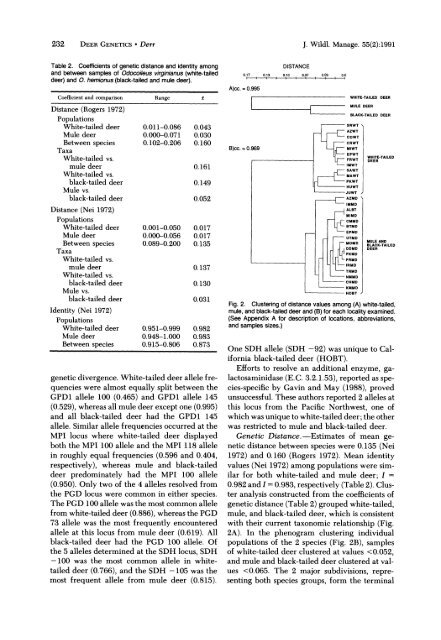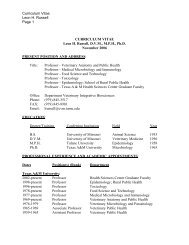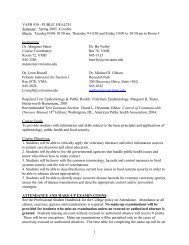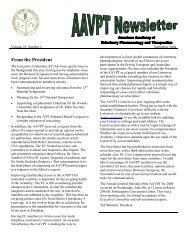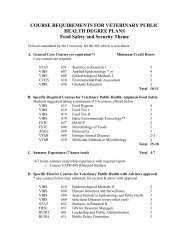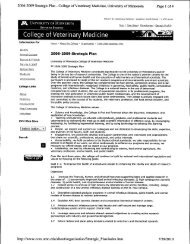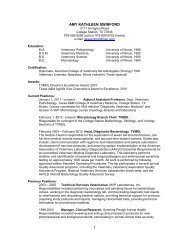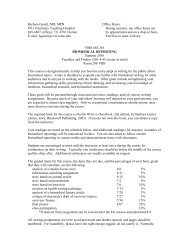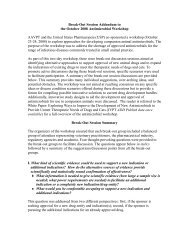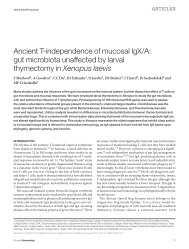Genetic Interactions between White-Tailed and Mule Deer in the ...
Genetic Interactions between White-Tailed and Mule Deer in the ...
Genetic Interactions between White-Tailed and Mule Deer in the ...
Create successful ePaper yourself
Turn your PDF publications into a flip-book with our unique Google optimized e-Paper software.
232 DEERGENETICS Derr J. Wildl. Manage. 55(2):1991<br />
Table 2. Coefficientsof genetic distance <strong>and</strong> identity among<br />
<strong>and</strong> <strong>between</strong> samples of Odocoileus virg<strong>in</strong>ianus (white-tailed<br />
deer) <strong>and</strong> 0. hemionus (black-tailed <strong>and</strong> mule deer).<br />
Coefficient <strong>and</strong> comparison Range<br />
Distance (Rogers 1972)<br />
Populations<br />
<strong>White</strong>-tailed deer 0.011-0.086<br />
<strong>Mule</strong> deer 0.000-0.071<br />
Between species 0.102-0.206<br />
Taxa<br />
<strong>White</strong>-tailed vs<br />
mule deer<br />
<strong>White</strong>-tailed vs.<br />
black-tailed deer<br />
<strong>Mule</strong> vs.<br />
black-tailed deer<br />
Distance (Nei 1972)<br />
Populations<br />
<strong>White</strong>-tailed deer<br />
<strong>Mule</strong> deer<br />
Between species<br />
Taxa<br />
<strong>White</strong>-tailed vs.<br />
mule deer<br />
<strong>White</strong>-tailed vs.<br />
black-tailed deer<br />
<strong>Mule</strong> vs.<br />
black-tailed deer<br />
Identity (Nei 1972)<br />
Populations<br />
<strong>White</strong>-tailed deer<br />
<strong>Mule</strong> deer<br />
Between species<br />
genetic divergence. <strong>White</strong>-tailed deer allele frequencies<br />
were almost equally split <strong>between</strong> <strong>the</strong><br />
GPDl allele 100 (0.465) <strong>and</strong> GPDl allele 145<br />
(0.529),whereas all mule deer except one (0.995)<br />
<strong>and</strong> all black-tailed deer had <strong>the</strong> GPDl 145<br />
allele. Similar allele frequencies occurred at <strong>the</strong><br />
MPI locus where white-tailed deer displayed<br />
both <strong>the</strong> MPI 100 allele <strong>and</strong> <strong>the</strong> MPI 118 allele<br />
<strong>in</strong> roughly equal frequencies (0.596 <strong>and</strong> 0.404,<br />
respectively), whereas mule <strong>and</strong> black-tailed<br />
deer predom<strong>in</strong>ately had <strong>the</strong> MPI 100 allele<br />
(0.950).Only two of <strong>the</strong> 4 alleles resolved from<br />
<strong>the</strong> PGD locus were common <strong>in</strong> ei<strong>the</strong>r species.<br />
The PGD 100 allele was <strong>the</strong> most common allele<br />
from white-tailed deer (0.886),whereas <strong>the</strong> PGD<br />
73 allele was <strong>the</strong> most frequently encountered<br />
allele at this locus from mule deer (0.619). All<br />
black-tailed deer had <strong>the</strong> PGD 100 allele. Of<br />
<strong>the</strong> 5 alleles determ<strong>in</strong>ed at <strong>the</strong> SDH locus, SDH<br />
-100 was <strong>the</strong> most common allele <strong>in</strong> whitetailed<br />
deer (0.766), <strong>and</strong> <strong>the</strong> SDH -105 was <strong>the</strong><br />
most frequent allele from mule deer (0.815).<br />
DISTANCE<br />
WHITE-TAILED DEER<br />
SRWT \<br />
AZWT<br />
COWT<br />
CRWT<br />
B)cc. = 0.969 MIWT<br />
IMWT<br />
SAWT<br />
MAWT<br />
PKWT<br />
HUWT<br />
JUWT /<br />
4AZMD )<br />
/ IMMD I<br />
UTMD<br />
MOMD<br />
DDMD<br />
PKMD<br />
FRMD<br />
IRMD<br />
TRMD<br />
NMMD<br />
WH!TE.TAlLED<br />
DEER<br />
MULE AND<br />
BLACK.TA1LED<br />
DEER<br />
Fig. 2. Cluster<strong>in</strong>g of distance values among (A) white-tailed,<br />
mule, <strong>and</strong> black-taileddeer <strong>and</strong> (B)for each locality exam<strong>in</strong>ed.<br />
(See Appendix A for description of locations, abbreviations,<br />
<strong>and</strong> samples sizes.)<br />
One SDH allele (SDH -92) was unique to California<br />
black-tailed deer (HOBT).<br />
Efforts to resolve an additional enzyme, galactosam<strong>in</strong>idase<br />
(E.C.3.2.1.53),reported as species-specific<br />
by Gav<strong>in</strong> <strong>and</strong> May (1988), proved<br />
unsuccessful. These authors reported 2 alleles at<br />
this locus from <strong>the</strong> Pacific Northwest, one of<br />
which was unique to white-tailed deer; <strong>the</strong> o<strong>the</strong>r<br />
was restricted to mule <strong>and</strong> black-tailed deer.<br />
<strong>Genetic</strong> Distance.-Estimates of mean genetic<br />
distance <strong>between</strong> species were 0.135 (Nei<br />
1972) <strong>and</strong> 0.160 (Rogers 1972). Mean identity<br />
values (Nei 1972) among populations were similar<br />
for both white-tailed <strong>and</strong> mule deer; I =<br />
0.982 <strong>and</strong> I =0.983,respectively (Table2).Cluster<br />
analysis constructed from <strong>the</strong> coefficients of<br />
genetic distance (Table 2) grouped white-tailed,<br />
mule, <strong>and</strong> black-tailed deer, which is consistent<br />
with <strong>the</strong>ir current taxonomic relationship (Fig.<br />
2A). In <strong>the</strong> phenogram cluster<strong>in</strong>g <strong>in</strong>dividual<br />
populations of <strong>the</strong> 2 species (Fig. 2B), samples<br />
of white-tailed deer clustered at values


